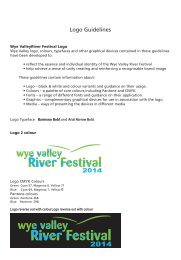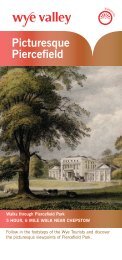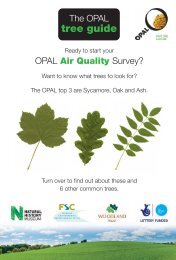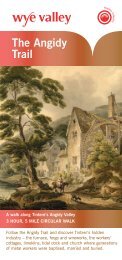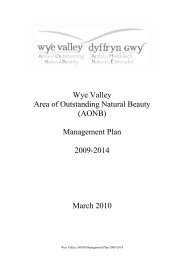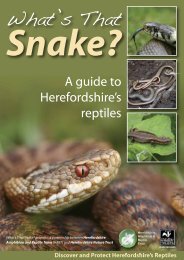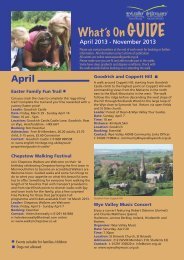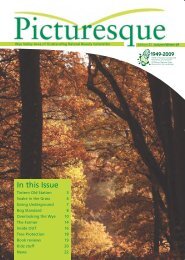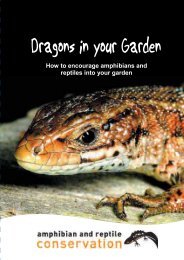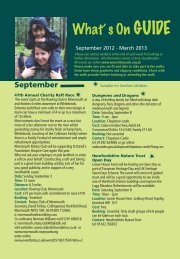Autumn 2010 - Wye Valley AONB
Autumn 2010 - Wye Valley AONB
Autumn 2010 - Wye Valley AONB
You also want an ePaper? Increase the reach of your titles
YUMPU automatically turns print PDFs into web optimized ePapers that Google loves.
the flight of thekingfisherBarry Embling RSPB Forest of Dean Managerdescribes the fascinating bird.A flash of electric bluealong the riverbank isquite often the way mostpeople see the CommonKingfisher, Alcedo atthisPeople new to birdwatchingoften say that this is the birdthat they most want to see.This perhaps comes from thefamiliarity that we all have forseeing this beautiful bird,depicted on crockery, bookcovers, calendars andChristmas cards...though notever seeing it in real life.The kingfisher has anastonishing electric-blue palesheen that can be seen bothat rest and when flying.Roughly sparrow-sized,it hasa dagger-like bill and a veryshort tail with vivid blueishgreen upperparts which arebeautifully complemented byrich orange under parts andbright red feet.Our kingfisher is a Northernoutlier of a mostly tropicalfamily, as evidenced by itsexotic looking plumage thatwould not look out of placepage 4in a rainforest. The closer onegets to the equator the moretypes of kingfisher there are,with 86 different speciesworldwide. The largest andperhaps even better knownkingfisher is the Australiankookaburra, but it has noassociation with water andfeeds mainly on reptiles andinsects. In Europe, our nonmigratoryBritish populationsare the most important in thewhole of Northern Europe, aswe are generally spared thefiercely cold, continentalwinters which can decimatenumbers.The breeding season lastsfrom late March to August.The nest is found at the endof a metre long tunnel that isexcavated by both the maleand female, drilled into avertical bank usually by slowmoving water. An enlargednest chamber is at the endthat rises slightly from theentrance. The 6-7 eggs areincubated by both parents,and in common with nearlyall hole-nesting birds (such asowls and woodpeckers), theeggs are white – as there’slittle need for camouflage ina dark nest chamber. Nonesting material is used,though there is anaccumulation of regurgitatedfish bones, accompanied nodoubt by a pungent odour.The young are fed by bothparents, and fledge in a littleover three weeks, oftenbecoming independentwithin days and leaving theparental territory. This is thetime of high mortality, withyoung birds often becomingwaterlogged and drowningwhilst learning to dive. This isalso the time of long distancedispersal due to youngstershaving to seek a territory oftheir own. Once this isestablished they become verysedentary.The habit of feeding almostexclusively on freshwater fishis one shared by the greyheron, both birds employingthe ‘wait and see’ hunting
technique. The kingfisherhowever, before swallowing,usually hits its prey againstthe perch to knock it out andthen the fish is swallowedheadfirst. Hunting involvespatient spying for prey froman open or concealed perchor hovering over water. Preyspecies typically caughtinclude bullheads, roach,minnows and stickle backs.Studies have shown thatwhen feeding young, theparents are able to bringback as many as 80 small fishin just one hour. A fish-onlydiet leaves a vulnerability tosevere winters. Before thehard winter of 1962/63 some32 pairs inhabited a 16 kmsection of the River Thames,this was reduced to a singlepair in the following summer.Large clutches, multiplebroods and good dispersalability when young areadaptations that allow arapid recovery after a hardwinter.An interesting occurrence inthe <strong>Wye</strong> <strong>Valley</strong> concernedthe peregrines at Symond’sYat Rock, as reported by oneof the RSPB volunteers. Theadult male peregrine took tospotting the kingfishers flyingalong the river and from thelofty cliffs of Coldwell Rocksand swooped down to riverlevel and successfully huntedthem, teaching the juvenileperegrines to do the same.That summer, four differentkingfishers were seen to betaken – certainly a recentlyfledged family.So, how can we find akingfisher? As with mostbirds, and all wildlife viewing,it boils down to lots of timein the field and luck. The wayI detect the kingfisher initiallyis hearing its ‘chee’ call, thenlooking up and down awater body to see the bluestreak shooting along abovethe water, with whirring wingbeats, briefly jinking sidewaysbefore landing on an oftenconcealed perch, or moreusually, disappearing aroundthe next bend.Whilst having tea on theDean Heritage Centre roofterrace that overlooks thebeautiful millpond, akingfisher landed on thesculpted metal dragon thatrises proudly from the centreof the pond. This allowed mebreathtaking views, especiallywhen it took off and brieflyhovered before dashingaway. Views such as this canonly leave one with a senseof privilege and awe.Kingfisher FactsThe Common Kingfisher ( Alcedo atthis)has two outer toes partly fused togetheror webbed.A family of Kingfishers can eat up to 100fish a dayBefore swallowing fish they usually hit itagainst the perch to knock it out.The fishis swallowed headfirstKinfishers are very territorial and willfight to protect their stretch of the riverThe Kingfisher colour is iridescence notpigment which is actually dark brown.Interference between differentwavelengths of light reflected fromdifferent layers of feathers producesblues, greens and oranges.The featherscan seem blue or green depending onthe angle they are viewed atThe average life span of the kingfisher isonly two years. However the oldest oneon record was 7.5 yearsThe courting ritual involves the maletrying to win female approval bybringing her foodThe kingfishers’ association withmankind goes back into ancient timesand it was once considered harmful tothe eyes to look at its brilliant plumage.Carrying a single feather was onceregarded as a talisman againstlightning…no doubt connected with itselectric blue plumage.The 19th centurynaturalist Yarrell, wrote that kingfisherswere regularly killed and hung by athread in country cottages, in the beliefthat the dangling corpse could indicatethe direction of the wind.For further information aboutKingfishers go the RSPB websitewww.rspb.co.ukpage 5
controllingwater pollutionWater quality has improved significantly due to increased legislation since the 1970’s,also because of better control of point source pollution which enters rivers through asingle point such as discharge from a sewage works. However, in recent years anotherserious malaise of water quality has become an issue in the form of ‘diffuse pollution’.Diffuse pollution is oftenmore serious than pointsource pollution, because it isharder to detect and prevent.It is often the case that thosecausing diffuse pollution areunaware of their actions.High water quality is animportant factor inmaintaining the aquatichabitats and species of theriver <strong>Wye</strong>. Acidification,nutrient enrichment and finesediment (silt) loads aresignificant factors affectingwater quality.Nutrients (nitrogen andphosphorus) affect sensitiveaquatic plants, which aredisplaced by the vigorousgrowth of nutrientdemandingplants such asfilamentous algae. At timesof low flow and high watertemperature this can alsopage 6lead to oxygen depletion, towhich juvenile salmon areparticularly sensitive.Sediments containing highphosphate levels can alsocause heavy mortality tosalmon at the egg stage bycausing oxygen depletionwithin spawning gravels.Agriculture is the mostsignificant source of nitrogenpollution on the <strong>Wye</strong>including fertiliser run-off,livestock manure, silageeffluent and soil erosion.Phosphates not only enterthe watercourse fromagricultural land but alsofrom poorly maintaineddomestic septic tanks.The nature of diffusepollution means that it isdifficult to tackle and a largenumber of individuallandowners need to beapproached to coversignificant areas. Face-to-facedelivery with landowners isparticularly important.To aid this work the EnglandCatchment Sensitive FarmingInitiative (ECSFDI) has beenestablished. Fifty catchmentsacross England (including the<strong>Wye</strong>) were identified aspriority areas for action.These were targeted under arange of measures aimed atimproving farm practices andreducing water pollutionfrom agriculture. Newlyappointed advisers areworking on a one-to-onebasis with farmers, as well asleading a series of initiatives,including workshops andfarm demonstrations toencourage best practice.Grants have been available tocarry out activity that will
For the love of WELLSbenefit water quality and onthe Welsh side of the <strong>Wye</strong>Catchment, the EnvironmentAgency have a CatchmentInitiative which works alongthe same lines as the ECSFDI,offering advice and guidanceto farmers on reducingdiffuse pollution.Locally, Ioan Williams hasbeen working with farmerson both sides of the border,and has recently been joinedby Kirstie Richardson workingfor the Environment Agency.Since 2006 over 300 farmershave had on-farm advice,and numerous farmermeetings and events havetaken place, this has helpedraise the level of awarenessof diffuse pollution, as well asimproving the relationshipbetween the EA and farmers.Any farmer or landowner whowishes to find out more aboutthe initiatives mentioned cancontact either Ioan or Kirstie on02920 582754 or visitwww.naturalengland.org.uk/ourwork/farming/csf/default.aspxWater is essential to life, and civilisations have always beenfounded on reliable sources of water.In the history of our own <strong>Wye</strong> <strong>Valley</strong> Area of Outstanding NaturalBeauty ( <strong>AONB</strong>) communities will have been originally sited on ornear a spring, well or watercourse.The village well would become anatural meeting place, and water sources would also often have aholy aspect. Many churches were founded on such sacred sites and itis believed that over 1,100 holy wells were known of in Wales in the1950s.Nowadays most of us depend on piped water brought from reservoirsoften many miles away. But somehow people and communities stillshow a basic need to appreciate and preserve ancient water sourcesthat have long ago lost their practical importance.A well is defined as a spring that man has adopted for water supplyand often there is some form of structure, which may include a basinor trough. Often the structure has fallen into decay but somecommunities have ensured their wells are preserved.Throughout the <strong>Wye</strong> <strong>Valley</strong> <strong>AONB</strong> we can still find wells that arecared for and visited.The Virtuous Well in Trellech, the St John theBaptist Well at Staunton and the Holy Well in Hole-in-the-Wall are justthree of the many venerated.The <strong>Wye</strong> <strong>Valley</strong> Society www.wyevalleysociety.org.uk inpartnership with the <strong>Wye</strong> <strong>Valley</strong> <strong>AONB</strong> is now starting a project toencourage communities to locate, log, look after and love their wells.The project aims to raise the profile of wells as historic parts ofcommunities and wherever possible restore and revitalise well sites.The parish and community councils of the area are being contacted,and help sought from local authorities, English Heritage, Cadw,Forestry Commission, water companies, local history and archaeologysocieties and the Wellsprings Fellowship,.But the success of the project will depend on the enthusiasm andenergy of local communities. Is there a water source near you thatyou believe was the supply for the community? Would you like to seeit restored and appreciated by everyone? We’d like to include waterfountains and locations where communities collected water fromstreams.Then contact the <strong>Wye</strong> <strong>Valley</strong> Society and tell us what you know onpress@wyevalleysociety.org.ukYou can view a list of known wells and springs in the <strong>AONB</strong> on theWellsprings Fellowship website onwellspringsfellowship.wordpress.compage 7
of deer on the internationallyimportant woodlands in the<strong>Wye</strong> <strong>Valley</strong> <strong>AONB</strong>. Cooperatingon a landscapescale is recognised as a moreefficient way to manageFallow deer as a herd (oftenover thirty animals) will movefreely across boundaries.They are even known to crossthe <strong>Wye</strong> near Symonds Yatand Redbrook.However, it should beremembered that in Britainthe deer‘s main predators(such as wolf and lynx) nolonger exist and man’sintervention is necessary inecological terms. Sufficientnumbers of does (females)have to be culled to preventover population. As Fallowdoes can produce ten fawnsor more over a lifetime, cullsof 20% of the femalepopulation may be requiredjust to keep the populationstable. The consensus in theDeer Management Groups isthat we have a healthypopulation of deer with fewdiseased or unhealthyanimals.Muntjac and Roe deer arealso starting to impact onthe area. Roe deer is a nativespecies which is morereclusive than Fallow andlives in small family groups oras a solitary animal ratherthan within herds.Muntjac were introducedfrom Asia and are muchsmaller with a hunchedappearance. Normally livingsingly or in small familygroups, they are uniqueamongst UK deer in that theybreed all year. In reasonableconditions adult does willproduce a single fawn everyseven months over abreeding life which may lastinto their teens.Muntjac are difficult to cullbecause they are small,inhabit thick cover and areconstantly on the move.All the deer species areexcellent to eat. Venison,properly cooked, is good ,healthy meat that is leanerthan chicken per 100g andfull of omega oils.However asthe meat becomes morepopular poaching is on theincrease. Poachers respectneither the season nor thedeer they kill, including fawnsand pregnant does and mayuse dogs to bring the preydown. Any suspicions thatpoachers are in your areashould always be reported tothe police. With a variedlandscape andlandownership there arealways natural refuges for thedeer to escape to.The Fallow Deer one of our mostcommon <strong>Wye</strong> <strong>Valley</strong> species of deerTypes of Deerfound in the <strong>Wye</strong><strong>Valley</strong>Fallow Deer Cervus damaOur most common deer in thearea. They were introduced intoBritain by the Normans in the11th century. They live in singlesex herds for most of the yearonly coming together inautumn for the rut when thewoods echo with the malesdistinctive grunt .Roe Deer Capreolus capreolusOne of our native species whichbecame largely extinct in the1700s. They are found assolitary animals or in familygroups not in herds.Muntjac Muntiacus reevesiSmall deer introduced intoWoburn Prk in the early 20thcentury. Escapees thenestablished a feral populationwhich has led to a widespreadincrease in numbers.Sika Deer Cervus nipponIntermediate size between redand roe deer. Introduced fromthe Far East in 1860s. Tend to besolitary for most of the year.The major threat is the geneticintegrity of the red deer as theSika will interbreed with reds.Red Deer Cervus elaphusThe largest native deer speciesin the UK. there are only a fewin the <strong>Wye</strong> <strong>Valley</strong>. The stags areknown for their spectacularautumn rut.For more information visitwww.thedeerinitiative.co.ukor the British Deer Societywww.bds.org.ukpage 9
Overlooking the <strong>Wye</strong> is a £2.8 m Landscape PartnershipScheme supported by the Heritage Lottery Fund within the <strong>Wye</strong><strong>Valley</strong> <strong>AONB</strong>.The aim of the scheme is to improve and promote enjoymentand understanding of the historic environment in the landscapeof the lower <strong>Wye</strong> <strong>Valley</strong>. This involves projects at forty sites.TimelessBeauty ofLancautFor one of the mostPicturesque locationswithin the <strong>Wye</strong> <strong>Valley</strong>Area of OutstandingNatural Beauty ( <strong>AONB</strong>)Lancaut really does takesome beating.The Lancaut Peninsula inGloucestershire is tucked inbelow the high limestonecliffs of the lower <strong>Wye</strong> <strong>Valley</strong>gorge. This quiet idyll wasonce home to an earlymonastic settlement and aleper colony. All that remainstoday is a shell of the 12thcentury church and itssurroundings.page 10St James is a small earlychurch positioned to look outover the River <strong>Wye</strong> andtogether with thesurrounding area isdesignated as a ScheduledMonument.During the spring of <strong>2010</strong>the ‘Overlooking the <strong>Wye</strong>’scheme undertook works toWork on the turf top wallLancaut Church remainsrepair the wall around thechurchyard which was fallingdown. Originally repaired as adrystone wall some years agothe new work was to put itback as a mortared wall witha ‘turf’ top. This is atraditional living solutionwhich will protect the wallfrom rain penetrating thestonework, provide adifferent habitat and will bein harmony with thelandscape. It is also mucheasier than sourcingmatching stone which canbe very expensive.In the first year the turf isexpected to suffer die backbut we anticipate that it willregenerate next spring. Thiswork will be finished in theautumn <strong>2010</strong>.
theteamThe OLW team of from left: Victoria Oaten, Outreach andInterpretation Officer, Kate Biggs, Project Officer, JulieGodfrey, Finance Officer and Sue Middleton, SchemeManager (pictured above)contact detailsSue Middletontel: 01600 891525email: sue@overlookingthewye.org.ukKate Biggstel: 01600 891526email: kate@overlookingthewye.org.ukVictoria Oatentel: 01600 891527email: victoria@overlookingthewye.org.ukJulie Godfreytel: 01600 891527email: julie@overlookingthewye.org.ukThe WYE TOUR and its ARTISTSChepstow Museum hasbrought back over 70watercolours of the <strong>Wye</strong><strong>Valley</strong> by great artists fromthe late 18th and early 19thcenturies to the source oftheir inspiration.This was the Golden Age ofBritish watercolour paintingand also the heyday of the <strong>Wye</strong>Tour, a two day boat trip fromRoss-on-<strong>Wye</strong> to Chepstow,probably Britain’s first ‘package’tour. These first touristsfollowed in the wake of theRev William Gilpin, whose bookpopularised the tour and thescenery. Many amateur as wellas professional artists came toseek out and capture the‘picturesque’ scenes.The exhibition brings togetherworks from museumsthroughout the UK and thenational collections in London(Tate, V&A, British Museum andBritish Library) as well as inWales. Masters from that greatage of watercolours, includingJMW Turner, Paul Sandby,Michael ‘Angelo Rooker,Thomas Hearne, EdwardDayes, John & Cornelius Varley,Samuel Palmer, David Cox,John Sell Cotman, John Martinand Joshua Cristall are shown.Guest curator, Julian Mitchell,known as playwright andscreenplay writer (AnotherCountry, Wilde, InspectorMorse etc) and also as aMonmouthshire historian whohas studied the tour and itsartists for twenty five years, hasselected ‘his best and mostinteresting’ watercolours.The exhibition was madepossible through a grant fromCyfoeth Cymru Gyfan –Sharing Treasures scheme fromthe Welsh AssemblyGovernment, administered byCyMAL, Museums Archivesand Libraries Wales.Don’t miss this exhibition of ‘national significance’Chepstow Museum, Bridge Street, Chepstow until September 5Open: Mon-Sat inc Banks Hols 10.30-5.30, Sun 2-5.30Admission FREETop: J M W Turner, Tintern Abbey, West front; the ruinedabbey, c 1794 © The Trustees of The British MuseumBottom: Thomas Hearne, Symonds Yat on the River <strong>Wye</strong>, ©The Whitworth Art Gallery, The University of Manchesterpage 11
AngidyfurnaceThe remnants of anhistoric industriallandscape, which oncedominated thesurrounding areas ofTintern can be discoveredamongst the woodlandtranquilityAngidy Furnace is located inthe Angidy <strong>Valley</strong> lying aboveTintern. This valley was oncean important industrial hubwith furnaces, forges andwireworks utilising the waterpower from the Angidy River.The site has had problemswith flooding for a number ofyears due to leaks from theriver and blockages in theunderground culvert whichhas led to deterioration of thesite. The Overlooking the<strong>Wye</strong> Scheme is currentlyworking to resolve this andconserve the monument.The site was used forsmelting iron from 1590 andwent out of industrial use inabout 1828. The remains onsite relate to the latest phaseof industrial activity. Industrialsites are always complexarchaeologically,modifications to buildingsand processes were oftenmade, with structures beingreused and changed. AngidyFurnace is no exception; weknow how the site workedand the functions of thebuildings, but understandinghow these have evolved fromearlier workings is difficult.The current work involvestrying to unblock a culvertthat runs from the wheel piton the site. This pit oncehoused the wheel thatgenerated power to blow theblast furnace. We will also beremoving the cement mortarfrom the remains of the wallsand replacing it with limemortar which is much lessharmful to traditionalbuildings. The work is beingdone by Ascend Ltd whohave been working with DrNeil Phillips (archaeologist) andthe Overlooking the <strong>Wye</strong> ProjectOfficer, Kate Biggs. Neil hopesthat new clues discovered duringthe works will help us tounderstand more of the historyof this important site.The work has also involveddigging a deep hole in theneighbour’s garden so we arevery grateful to Janet and BarrySaunders for their help andtolerance! More updates later!Dr Neil Phillips and Darren Richardsoninvestigating culvertsFor more information contact:Angidy Furnace: Kate BiggsKate@overlookingthewye.org.ukpage 12
NEWSOverlooking the <strong>Wye</strong> Minibus ToursOne of the successful mini bus toursThe Overlooking the <strong>Wye</strong> teamhave started running guidedminibus tours around some ofthe historic sites in the scheme inorder to explain the works beingdone. There are two routes andeach trip takes a whole day as itincludes lunch and tea stops at asubsidised cost of £15 per head.The tours are available to tourismbusinesses, local councillors, localinterest groups and the generalpublic.If you wish to find out more,please contact Julie Godfrey (tel:01600 891 527 or emailjulie@overlookingthewye.org.ukOld Station Tintern re-opensLlandogo bridge and footpathLlandogo FootpathThe works to improve thefootpath down to theriverside completed anotherlink in the circular routearound Llandogo. Theseworks were done byMonmouthshire CountyCouncil Rights of Waydepartment.Old Station, Tintern wasofficially re-opened on Fri16th July by Peter Clarke, thechairman of MonmouthshireCounty Council, ably assistedby Giles Howard and AnnWebb (MCC CountyCouncillors) and MargaretJones (Countryside Councilfor Wales). This marked thecompletion of therefurbishment works with theprovision of the all abilityaccess ramp so that all visitorscan now enter theDestination <strong>Wye</strong> <strong>Valley</strong>Exhibition.page 13
working in the <strong>Wye</strong>thegamekeeperPeter Clay’s Perrystone Estate in Herefordshireis one of the prime sporting estates in the <strong>Wye</strong><strong>Valley</strong> <strong>AONB</strong>. With a rich biodiversity itscontribution to the landscape and wildlife isan important oneAdrian Hanks, HeadKeeper at the PerrystoneEstate in Herefordshireexplains about the job andits importance in natureconservation.eAdrian is now in his 26thseason at the 2,200 acrePerrystone Estate whichprovides pheasant andpartridge shooting. Originallya stockman with pedigreeHerefords he started out byhelping lady keeper RosieTristram at Upton Court. Hewent as a keeper/stockmanat Ingstone Foy with JimmyFerrard, then was sent totrain for twleve monthsunder Henry Fanner andPeter Masters at Perrystone.He went from there back topage 14Ingstone to start a brand newshoot. From there he went toNorthwick in the Cotswolds.Whilst there he beat all therecords for pheasant andpartridge on the estate.Returning to Perrystone hebecame head keeper aftertwo years, a position he hasheld ever since.A natural countryman,Adrian is heartfelt in his lovefor his birds and theHerefordshire countryside. ‘ Ilove the wildlife. This is not ajob but a way of life. I lookafter the birds and when Ipresent them well at theshoot I know I have done myjob. However I do get a bit ofa kick to see birds beat theguns and get through.’A gamekeeper’s job involveslong hours and completededication. There are a lot ofthings that predate the birdsand in the run up to theseason Adrian and underkeeper Aaran are out fromdawn to dusk feeding birds,running vermin traps forcrows, magpies and squirrels,checking pens and ensuringthe birds are kept in the bestof health in the run up to theshoot.One of the essential parts ofestablishing and maintaininga good shoot is to ensure thebirds have shelter andwarmth, pheasants do notstand up well to the cold andcoverts are estabished withtrees and crop areaswhere
the birds can shelter andfeed. Perrystone Estate hasplanted 130 acres of covertcrops which not only provideseeds for the pheasants butfor a variety of songbirdswhich are now on theincrease on the estate. Larksparticularly seem to bebenefitting from this type ofmanagement and thesongbird population hasincreased by 70%. Added tothis the forestry workers haveplanted 20,000 native oaks inthe last two years, firs arebeing removed and nativetrees and shrubs replanted.The site is classed as anoriginal ancient forest siteand contains some reallygood specimans of ancientoak and some fine examplesof field maple.The relatively untouched landnow boasts a very healthyBrown Hare population butall in the garden is not rosy.Poaching is now on theincrease and has seen therapid decline of the fallowdeer on the estate. Thearrival of the goshawk hasseen large numbers of birdsincluding sparrow hawkdeclining. Goshawks haveeven been predating on barnowls and have decimated thegrey partridge that werebeing raised in a speciallyconstructed 450 acre area.The reintroduction of thepartridge is important andpoults will be introduced torestock the area.The Perrystone pheasants area source of pride to Adrianand they rear several speciesfor game shooting . As wellas the Common PheasantPhasianus colchicus theestate runs an exotic speciesthe Reeves PheasantSyrmaticus reevsii If guestsshoot these they pay a forfeitwhich goes to named charityeach year. Several thousandpounds have been raised thisway for local charities.Game shooting andconservation are workingtogether to reverse thedecline of some of ourthreatened native species andshould be viewed as animportant contribution to ourenvironment in the <strong>Wye</strong><strong>Valley</strong> <strong>AONB</strong>.Game SeasonFor a variety of species the shootingseason has closed and openseasons.The closed season, theperiods they cannot be shot,generally coincides with thebreeding season to ensure a heathyand sustainable population ismaintainedGame Open Seasons(England and Wales)Pheasant Oct 1 - Feb 1Partridge Sept 1 - Feb 1Grouse Aug 12 - Dec 10Ptarmigan Aug 12 - Dec 10Snipe Aug 12 - Jan 31Woodcock Oct 1- Jan 31For further information pleasego to the following websitesFarming and Wildlife Advisory Groupwww.fwag.org.ukGame and Wildlife Conservation Trustwww.gwct.org.ukBritish Association for Shooting andConservationwww.basc.org.ukNational Gamekeepers Organisationwww.nationalgamekeepers.org.ukCountryside Alliancewww.countryside-alliance.org.ukCountryside Land and BusinessAssociation www.cla.org.ukHELP STOP POACHINGKeepers are now asking for thegeneral public’s help in reporting anystrange lights or activities they see atnight in the countryside to the police.The more eyes out there the better.Above: Adrian Hanks and beat keeper Aaran Hocking patrolling the pheasant pensLeft: The Reeves Pheasant at Perrystonepage 15
TraditionsandCustomsin the <strong>Wye</strong> <strong>Valley</strong>The Forest of Dean is aplace full of ancientcustoms and traditionone of these being the'St Briavels Bread andCheese Dole'Every Whit Sunday afterevensong has been heard inSt Mary’s church a crowdgathers beneath a high wallin the pretty Gloucestershirevillage of St Briavels, highabove the <strong>Wye</strong> <strong>Valley</strong>. Theyare waiting for bread andcheese, but not a niceploughman’s supper orsandwich. They soon get it, orthe chance to grab it, as twofigures lob small pieces ofbread and cheese at themfrom above, picking the foodfrom large baskets. There is ascramble, as these morselsare said to have specialproperties: to last withoutspoiling; to bring good luck(local miners used tthem ascharms to preventunderground accidents); or tohelp the holder see into theAbove: Bread and Cheese Dole in actionAbove: St Mary’s Church and the Castle at St Briavelsfuture if kept beneath theirpillow.The scramble today is said tobe more sedate than it usedto be, but then WagonWheels are smaller and itdoesn’t snow as much inwinter does it? At one timethe event took place in thechurch itself, but therowdiness was felt to beunbecoming to a place ofworship, so long ago itmoved to the lane outside.These days some claimantsdress in medieval garb,reflecting the belief that thecustom dates back manycenturies. It is said by some tohave originated at the time inthe 12th century when Milesde Gloucester, subsequentlymade Earl of Hereford,commanded the castle in thevillage, guarding the landagainst incursions bymarauding Welshmen. ThoseSt. Briavels (pronounced‘Brevels’), was once known as'Ledenia Parva' (Little Lydney)and stands on the edge of alimestone plateau above thevalley of the River <strong>Wye</strong>, juston the English side of theWelsh border, above anancient ox-bow of the river.who paid a penny ‘dole’ tothis lord were granted theright to gather firewood inHudnalls Wood in the district,though quite how this islinked with the distribution ofbread and cheese nobody issure. Alternatively, the customcould date from a visit byKing John to the village, andthe grant of a large area ofland to the villagers, thoughthis seems entirely out ofcharacter for that financiallyembarrassed monarch.St Briavels is in the Forest ofDean, an area with morethan its fair share oftraditional rights – the use ofcommon land for grazing, therights of those born locallywho have worked for a yearand a day in certain trades tomine where they please in theforest, and so on. People inthe area are keen to retaintheir traditions, which inmany cases convey economicbenefits, so it is likely thebread and cheese willcontinue to be thrown to thewaiting crowd every Whitsunin this lovely part of thecountry, much to the delightof visitors.page 16
ProjectLemurKat White’s training with the<strong>Wye</strong> <strong>Valley</strong> <strong>AONB</strong> throughProject LEMUR is providingher with vital skills forworking in theenvironmental andconservation sectorsFinding jobs in today’srecession is difficult enoughand many environmentalgraduates are finding thatthey may have the academicqualifications but without thepractical skills they are unableto find work.Kat White from Barry, SouthWales was in such a position,until help came from ProjectLEMUR ( LearningEnvironments in Marine,Urban and Rural areas) inpartnership with the <strong>Wye</strong><strong>Valley</strong> Area of OutstandingNatural Beauty (<strong>AONB</strong>).Graduating in 2004 inEnvironmental Biology andwith a Masters degree inConservation and Utilisationof Plant Genetic Resourcesfrom the University ofBirmingham, Kat was findingit tough to get a job inconservation. ‘I had greatdifficulty in getting any workother than two six monthperiods as a countrysideseasonal ranger’ she said. ‘Ifound that my lack ofknowledge in species‘identification let me down.’Funded through the HeritageLottery Fund and run locallyby the Herefordshire NatureTrust for the rural hub,LEMUR is an initiativeproviding a lifeline of trainingin practical wildlifeconservation skills withconservation bodies like the<strong>Wye</strong> <strong>Valley</strong> <strong>AONB</strong>. Katjoined the <strong>AONB</strong> unit in Apriland will be training for ninemonths in surveying ofveteran trees, grasslandhabitats, bats and workingon a High Nature ValueFarmland survey. She will alsoget hands on experience withthe courses, events andactivities run throughout theyear. Andrew Nixon, <strong>Wye</strong><strong>Valley</strong> <strong>AONB</strong> DevelopmentOfficer was pleased towelcome her to the team.‘With her past experience shewill make a valuablecontribution to the importantsurvey work we need to carryout this year.’With her new skills Kat willbe in a much strongerposition to nail thatconservation job she isdreaming of and which the<strong>Wye</strong> <strong>Valley</strong> <strong>AONB</strong> will havepaid a strong part.For more details aboutLEMUR log ontowww.projectlemur.orgpage 17
Farming Awards <strong>2010</strong>The judging has finished for the <strong>2010</strong>farming awards for large farms over 100hectares. The award was presented at theMonmouthshire Show in AugustFrom this yearscompetition three farmswere selected for the finalpresentation atMonmouthshire Show onThursday, August 26.From the finalists BrookesDairy, Panta Farm,DevaudenPencoyd Court Farm,Herefordshire and CaplorFarm Fownhope, the judgeschose Gareth Williams fromCaplor Farm as the outrightwinner. It was a difficult taskjudging three strongcontenders for this year’sawardsAndrew Nixon, <strong>Wye</strong> <strong>Valley</strong><strong>AONB</strong> Development Officer,said “ the Judges were veryimpressed by the diverseinitiatives at Caplor Farm.Gareth Williams hasdeveloped a forward thinkingapproach to farming thatreduces carbon emissions,maintains a high qualitylandscape and supportswildlife. Gareth is also verysupportive of his localcommunity as well as helpingcommunities in Gambiathrough Concern Universal.Caplor Farm is quite an oldhand at winning awards. Thispage 18year alone it was named asone of the top 50 GreenLeaders in the West Midlandsin a competition run bySustainibility West Midlandsand awarded first place in thecategory for small business inthe Carbon Reduction CostSaving award, as part of theWest Midlands Low CarbonEconomy Awards. Caplor alsopicked up a highlycommended award for itsexceptional level ofenvironmental commitmentfrom the Hereford andWorcester Chamber ofCommerce.The family business hasoperated from Caplor since1923, originally run byGareth’s grandfather. Initiallythe 323 hectare farm was fordairy production but Caplorhas divesified into arablefarming, which now has 170hectares of combinable cropsincluding wheat, oilseed rape,oats and beans. The farm alsohas over 80 hectares of grassand contracts 60-80 hectaresof potatoes annually. Apartnership with Phoclepedigree Herefords hasresulted in a new enterprisewith this award winning herd.One of the passions fuellingthe farm is Caplor Energywhich has been designedaround the farm’s ethos forenvironmentally sustainablefarming. The farm undertakesan annual carbon footprint tomonitor improvements andidentify areas for furthercarbon reduction. This hasenabled them to set up acompany for renewable energyinstallation . Caplor Energyprovides energy systems forhouseholds, communities andsmall businesses specialising insolar hot water systems, solarelectric systems. air source heatpumps and ground source heatpumps.Caplor seems to be a force forthe future of farming in theHerefordshire area and wecongratulate them on winningthis prestigious award.Background image Hereford herd at CaplorAbove: Gareth with son David
ook reviewsA regular feature of book reviewsconcerning the <strong>Wye</strong> <strong>Valley</strong> area,conservation and the environmentThe Wild Life: A year of Living on Wild FoodJohn Lewis-StempelPublisher: Black SwanISBN-055277460XPrice: Softback £8.99John Lewis-Stempel is a writer and farmer livingnear Ross on <strong>Wye</strong> in Herefordshire.The Wild Life ishis account of twelve months he spent eating onlyfood that Nature provided for free. He existed onfood he shot, found or foraged from fields, trees,hedges, copses and the brook running through hisfields. His account details the highs and lows of thisexistence and together with interesting recipesconjures up a real taste of the history of his 500year old farm.This book is a celebration of the countryside, earthy,passionate,honest and funny and with a beautifulwriting style that is a lesson in living off the land forus all.From all local bookshopsLandscapes on the EdgePublisher: Fineleaf EditionsPrice: £10.95This anthology of poems reflects many aspects of the magical landscapeof the River <strong>Wye</strong> and the Welsh Marches. The work of over thirty writersincluding local poets features work by Frances Horovitz, Anne StevensonNational Poet of Wales, Gillian Clarke, Edward Thomas, John Drinkwaterand Billy Collins US poet laureateAvailable from all local bookshops or ordered directly from FineleafEditions, Moss Cottage, Pontshill, Ross-on-<strong>Wye</strong> HR9 5TBwww.fineleaf.co.ukIf you have a book for review in our next issue please contact Nikki Moore,<strong>AONB</strong> Information Officer Tel: 01600 710846page 19
KIDZ stuffeventsAny of the events below can bebooked using the details beloweach event.Chepstow Museum’s BigDraw Event FramedGet hands on with the art andnature of the <strong>Wye</strong> <strong>Valley</strong> - and put itall in a pictureDate: Sunday October 10Time: 10:00am - 4.00pmLocation: Chepstow Drill HallContact: 01291 625981chepstowmuseum@monmouthshire.gov.ukBeastly and Beautiful BadgerWild Events in the <strong>Wye</strong>Beastly and Beautiful eventA group of young storytellers gathered at the Manor Wood onJuly 27 and took part in a woodland adventure; a quest to findthe key to the golden casket. En-route they encounteredwoodland creatures some real, a badger and a tawny owl, someimaginary, fairies and a wood wizard. At the end of the magicaltrail the golden casket was unlocked and everyone shared thesecrets of storytelling.There are always childrens events going on in the <strong>Wye</strong> <strong>Valley</strong><strong>AONB</strong>. Keep a lookout for <strong>Wye</strong> So Special or go onlinewww.wyevalleyaonb.org.ukSome really useful kids sitesRoyal Society for the Protection of Birds www.rspb.org.ukWorld wildlife fund – gowild.org.ukCbbc – www.bbc.cco.uk/cbbc/wild/index.shtmlWildlife watch – www.wildlifewatch.org.ukInsects – www.bugslife.co.ukNature Detectives – www.naturedetectives.org.ukHalloween Walk at OldStation TinternJoin us if you dare for a ‘ghoulishlygood’ early evening walk for all thefamily on All Hallows Eve. Pass thehaunted station and continue alongthe creepy railay line with spookystories and terrifying tales. Come infancy dress but wrap up warmlyand expect mud underfoot.Date: Sunday, October 31Time Call for detailsContact: MonmouthshireCountryide Service 012916895661Do you have any photos orartwork of the <strong>Wye</strong> <strong>Valley</strong>, itswildlife or landscape? Maybepics of you and your friendsand family having fun ormaybe a joke or two.If you would like to see them onthe KIDZ stuff page thensend to:The Editor, Picturesque,<strong>Wye</strong> <strong>Valley</strong><strong>AONB</strong>, Hadnock Road, MonmouthNP25 3NGor email them toinformation@wyevalleyaonb.org.ukpage 20
courtesy of www.thekidsgarden.co.ukI have no eyes, legs or ears and I helpmove the earth. What am I?A WORMpage 21
NEWSpage 22from the <strong>Wye</strong> <strong>Valley</strong> Area of Outstanding Natural BeautyinsideOUTopens newsite inWalesThe <strong>Wye</strong> <strong>Valley</strong> Area ofOutstanding NaturalBeauty(<strong>AONB</strong>) projectinsideOUT has been goingfrom strength to strengthat its Forestry Commissionsite at Bracelands in theGloucestershire section ofthe <strong>Wye</strong> <strong>Valley</strong> <strong>AONB</strong>.The project deliveredworkshops to over 100 usersfrom a wide variety of groupswho find difficulty inaccessing our superblandscape. Our aim to getCarrie from Grapevine Careadmires her wind sculptureFrom left: Roger Drury Soundworks, Sarah Goodey Gwent Arts and Health, Andrew Nixon <strong>Wye</strong><strong>Valley</strong> <strong>AONB</strong> Development Officer, Ashley Thomas Chairman <strong>Wye</strong> <strong>Valley</strong> <strong>AONB</strong> Joint AdvisoryCommittee, Jane Spray creative artist, Councillor Ann Webb, Stephanie Poulter repTrellechCommunity Council, Louise George Health and Social Care Facilitator GAVO, Richard GableForestry Commission Wales, Matthew Lewis Monmouthshire County Council CountrysideManager, Heidi Vaughan Head of Learning Oxford Playhouse, Andrew Blake <strong>Wye</strong> <strong>Valley</strong> <strong>AONB</strong>Lead Officer, Linda Steiner Alzheimers Society and Sarah Sawyer <strong>Wye</strong> <strong>Valley</strong> <strong>AONB</strong> CommunityLinks Officer. Front: Justine Wheatley Arts Alive and Sharon Seymour <strong>Wye</strong> <strong>Valley</strong> <strong>AONB</strong> Financeand Administration Officersites established inHerefordshire andMonmouthshire has taken astep forward. In Julyrepresentatives from localgovernment, social services,care providers and artspractitioners came togetherto officially open a new siteat Whitestone, a ForestryCommission Wales site.With support from RichardGable, Forestry CommssionWales and in partnershipwith Arts Alive, a creative artsorganisation fromCrickhowell, the insideOUTsite will enable groups towork creatively in thelandscape with specialist artsworkers.Justine Wheatly, Director ofArts Alive felt that the projectwould reflect herorganisation’s ethos ofworking with underrepresented and vulnerablegroups. ‘ Arts Alive isdelighted to partner the <strong>Wye</strong><strong>Valley</strong> <strong>AONB</strong> in this excitingnew project forMonmouthshire. I hope thatmany groups will be able toaccess the landscape that weall take for granted’The project intends todevelop links withcommunity and voluntarygroups particularlyfrom theNHS and social care sector.For further informationplease contact:Nikki Moore <strong>Wye</strong> <strong>Valley</strong><strong>AONB</strong> Information Officer atinformation@wyevalley<strong>AONB</strong>.org.uk or tel 01600 710846
National Association NewsAshley Thomas, who has served for several years asChairman of the <strong>Wye</strong> <strong>Valley</strong> Area of OutstandingNatural Beauty <strong>AONB</strong> has just finished a successfulthree year period as Chairman of the board of theNational Association of Areas of Outstanding NaturalBeauty NA<strong>AONB</strong>. He will still continue to serve as amember of the management board.Ashley Thomas (left) is pictured below at the National Conferencepresenting the Bowland Award to Sam Ellis from the charity ButterflyConservation. This award was gained for work on Denge Woods butterflyconservation project in Kent.World Heritage Status bidTourism and Heritage Minister John Penrose haspublished the UK’s Tentative List of 38 sites for WorldHeritage status which includes the <strong>Wye</strong> <strong>Valley</strong> and Forestof Dean. The area will be up against such iconic UKlandscapes as The Lake District and the Broads as well ashistoric towns of York, Bristol and Lincoln. The others infor consideration for the next round also include theIsland of St Helena and the Carribean Turks and CaicosIslands . Places finally winning through will join the TajMahal, the Great Wall of China, The Statue of Liberty andmore than 800 other sites on UNESCO’s list of the mosticonic and important parts of the planet’s heritage. Anindependent expert panel will now be set up to assesseach bid with a new list of potential sites drawn up forsubmission to UNESCO in 2011.<strong>Wye</strong> <strong>Valley</strong> <strong>AONB</strong> Calendar andAnnual ReviewOur extremely popular calendar for 2011 will be produced inAugust <strong>2010</strong>. Copies will be limited so we are organising anorder service.Order your calendar, priced at £5 inc post and package, fromthe <strong>Wye</strong> <strong>Valley</strong> <strong>AONB</strong> Unit, Hadnock Road, Monmouth NP253NG by May 31st to ensure your copy and please makecheques payable to Herefordshire Council.40 Years Ona celebration of the <strong>Wye</strong> <strong>Valley</strong> Areaof Outstanding Natural BeautyIn 2011 the <strong>Wye</strong> <strong>Valley</strong> <strong>AONB</strong> will becelebrating its 40th Anniversary. It wasdesignated in 1971, the same year as Britainwent decimal and the Italian Job hit the bigscreen.The primary purpose of the designation is toconserve and enhance the beauty of the <strong>Wye</strong><strong>Valley</strong> including its physical, ecological andcultural landscape. It has secondary aims ofmeeting the needs of quiet enjoyment of thecountryside and have regard or the interests ofthose who live and work in the <strong>Wye</strong> <strong>Valley</strong>. Inpractice this means the <strong>AONB</strong> unit togetherwith its Joint Advisory Committee andpartners are responsible for managing andprotecting the area recognising this is a livingand working landscape.We have plans to celebrate not only the 40years of partnership working but also theculmination of the Overlooking the <strong>Wye</strong>scheme with events throughout 2011. So dowatch out for information on our websitewww.wyevalleyaonb.org.uk and here inPicturesquepage 23
your feedback.Please let us know your views on this issue and win a copy ofLandscapes on the Edge published by FineleafAll replies will be entered in a Prize Draw to be drawn February, 2011Congratulations to G Purrier from Lydbrook winner of the Spring draw. A copy pfThe Railway Story by Eric Rawlins is on its way to you.Who’s whoAndrew Blake<strong>AONB</strong> OfficerName: ....................................................................................................Address: ............................................................................................................................................................................................................................................................................................................................................................................ Postcode: ..............................................Email: ....................................................................................................Which feature interested you the most? please tickBioblitz The Kingfisher Deer ManagementWater Pollution Overlooking the <strong>Wye</strong> The GamekeeperFarming Awards Lemur Traditions and CustomsKidz Stuff inside OUT Book Reviews NewsWhere did you obtain your Picturesque copy?........................................................................................................Would you like to receive Picturesque regulary?Yes please put me on the mailing list NoPicturesque is available as a pdf which can be emailed directly toyou. Please tick if you wish oneYes, I would like a pdf emailed to meIf your details are on our mailing list and they need amending please tickthe box and make sure the correct details are entered in the address boxabove.Please return to: Nikki Moore, Information Officer, <strong>Wye</strong> <strong>Valley</strong> <strong>AONB</strong>,FREEPOST SWC4106, Monmouth NP25 3ZZData Protection Act: If you have asked to be added to our mailing list for Picturesque,your contact details will be put on the database and used only for the purposes ofthe <strong>Wye</strong> <strong>Valley</strong> <strong>AONB</strong>Picturesque is printed on FSC stockLarge print version of Picturesque is available on requesttel: 01600 713977Email: office@wyevalleyaonb.org.ukSharonSeymourFinance andAdministrationOfficertel: 01600 713977Email: office@wyevalleyaonb.org.ukAndrew NixonDevelopmentOfficertel: 01600 710841Email: development@wyevalleyaonb.org.ukNikki MooreInformation Officertel: 01600 710846Email: information@wyevalleyaonb.org.ukSarah SawyerCommunity LinksOfficertel: 01600 710844Email: community@wyevalleyaonb.org.ukwww.wyevalleyaonb.org.ukPicturesque is produced at the <strong>Wye</strong> <strong>Valley</strong> <strong>AONB</strong> Office, Hadnock Road, Monmouth NP25 3NG Tel: 01600 713977 Fax: 01600 772051The <strong>Wye</strong> <strong>Valley</strong> <strong>AONB</strong> is supported by Countryside Council for Wales, NaturalEngland, Forest of Dean District Council, Herefordshire Council,Gloucestershire County Council and Monmouthshire County Council



